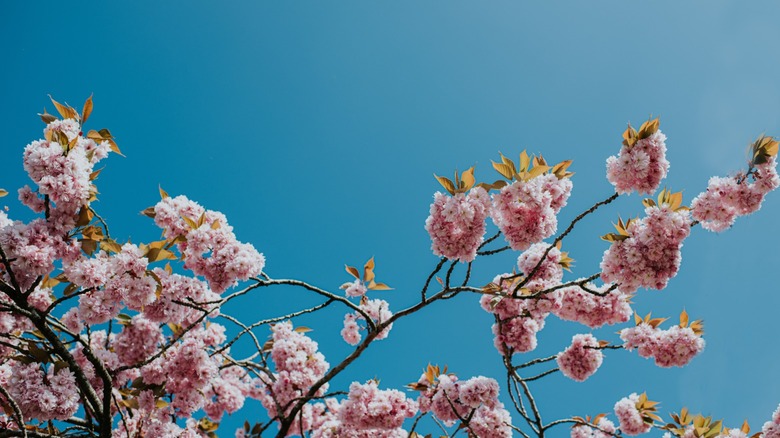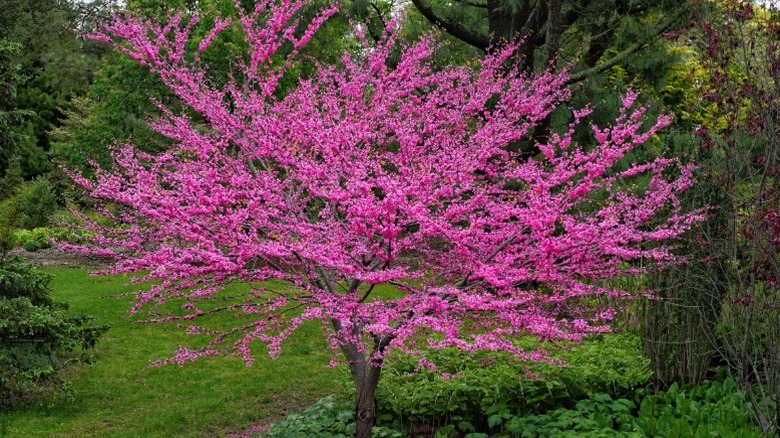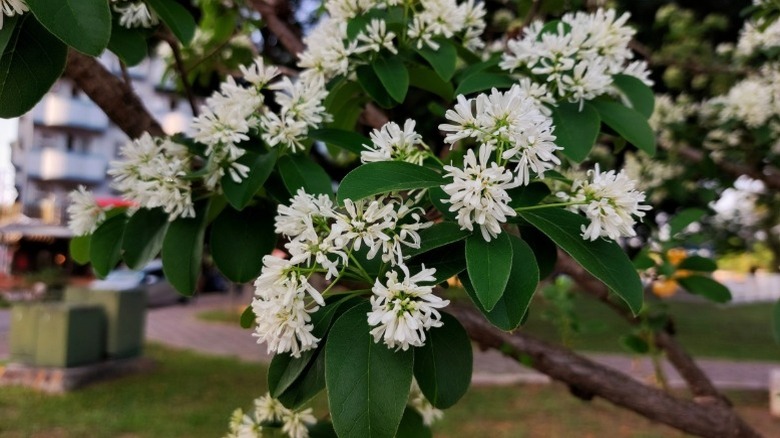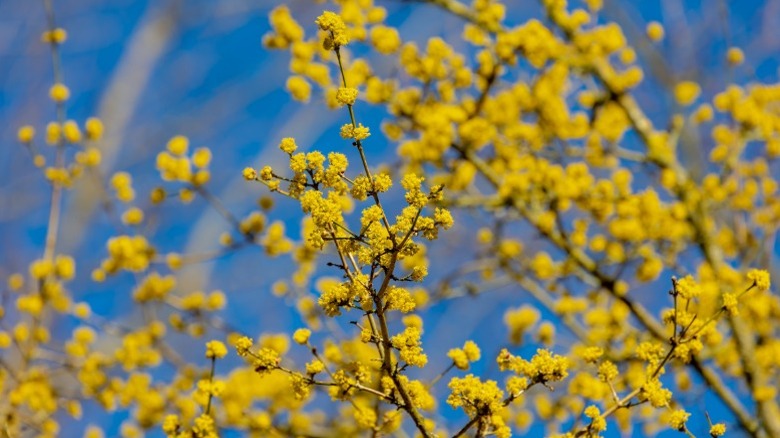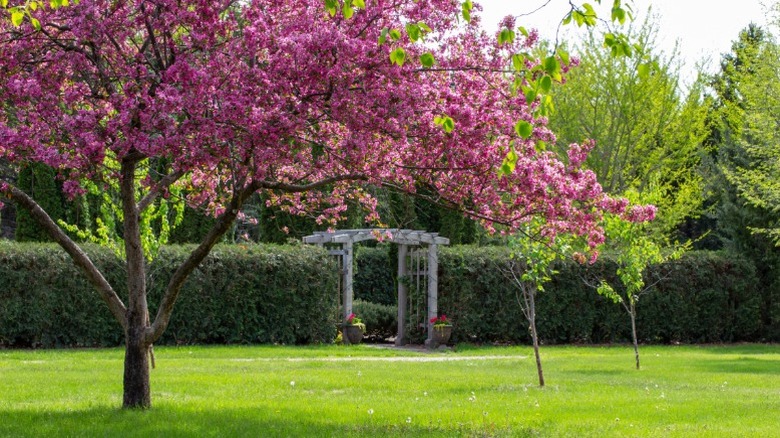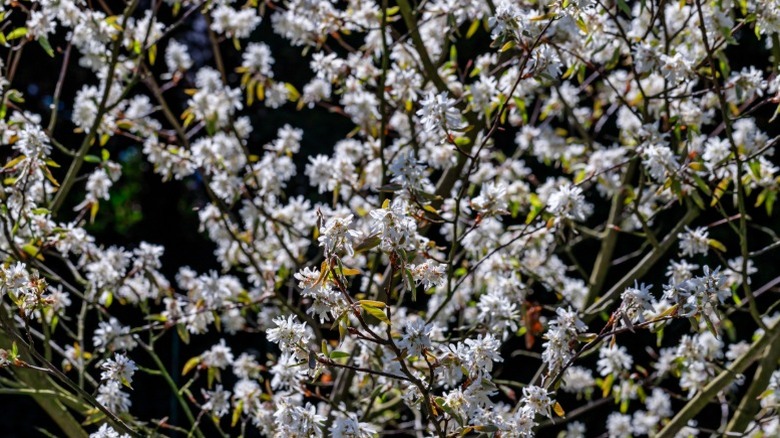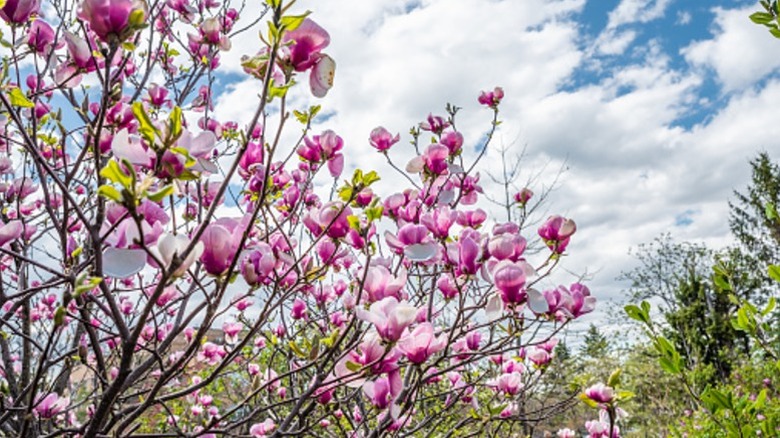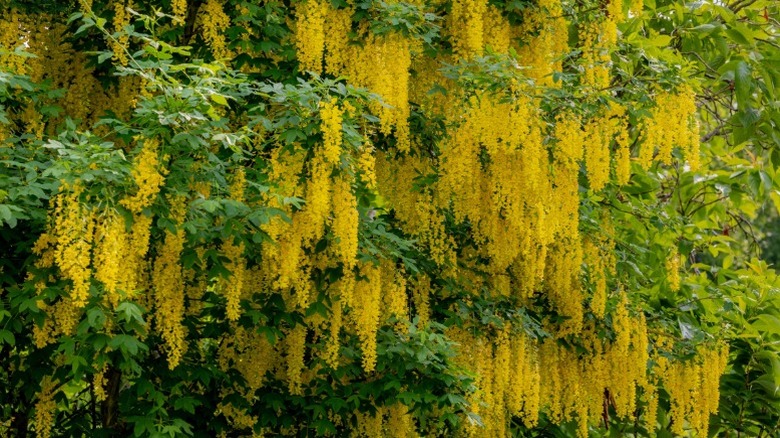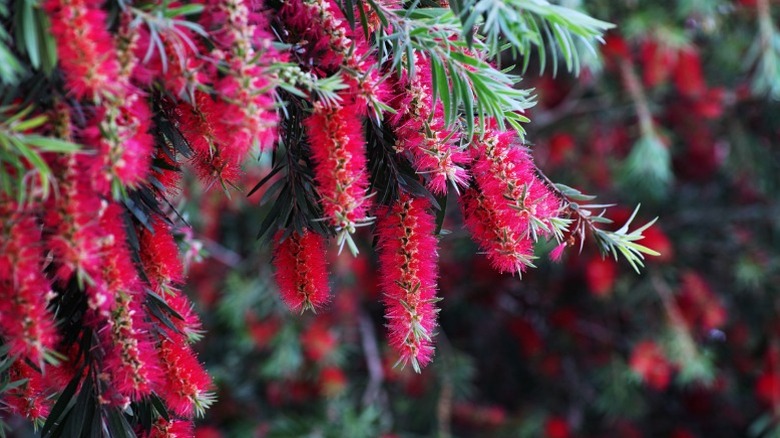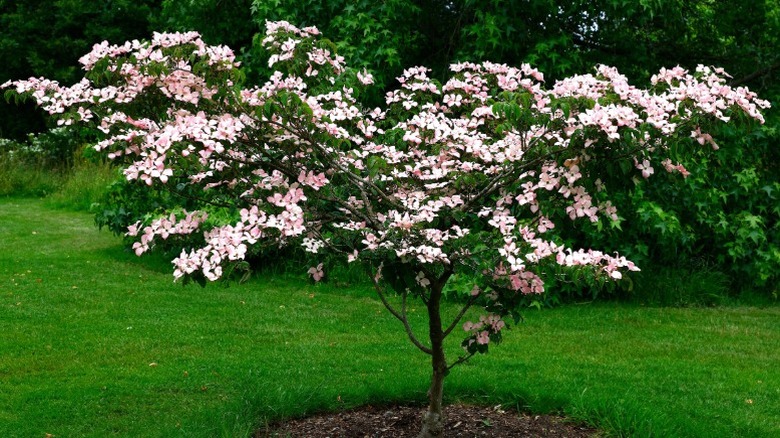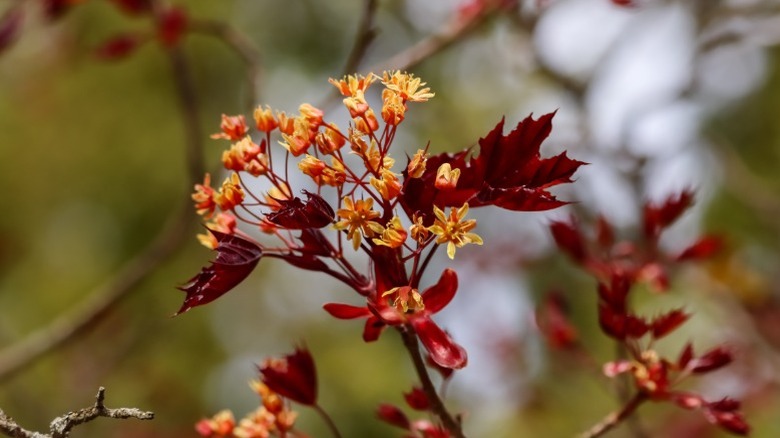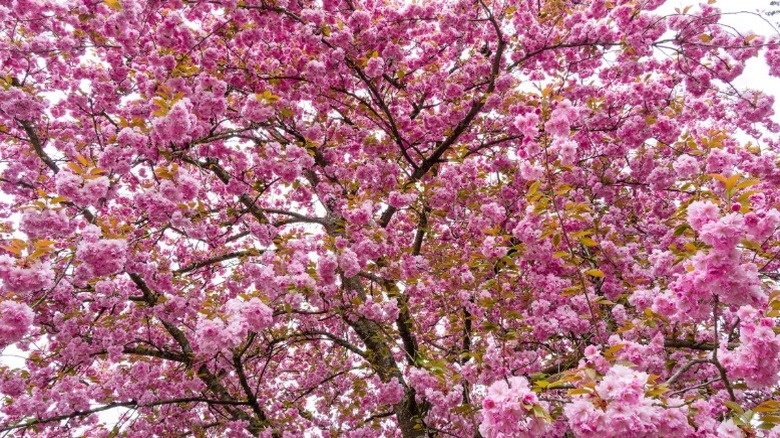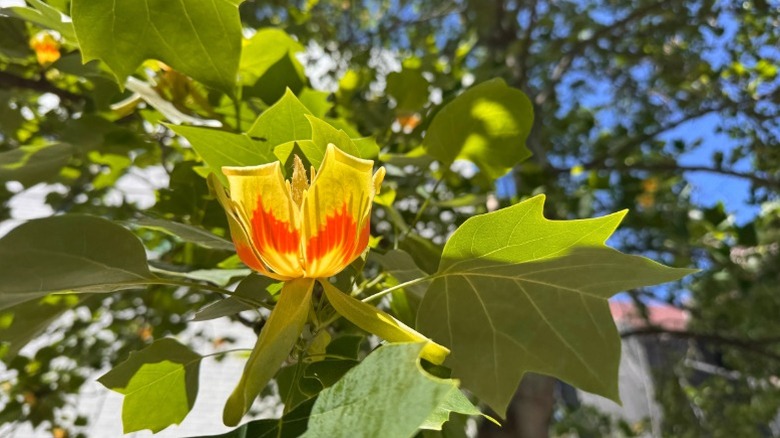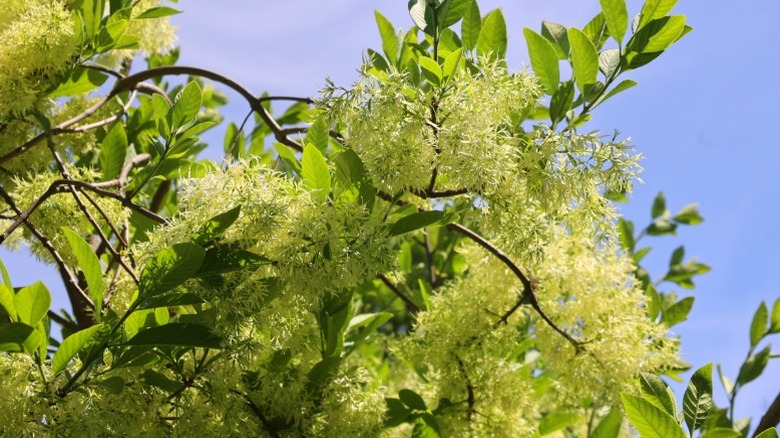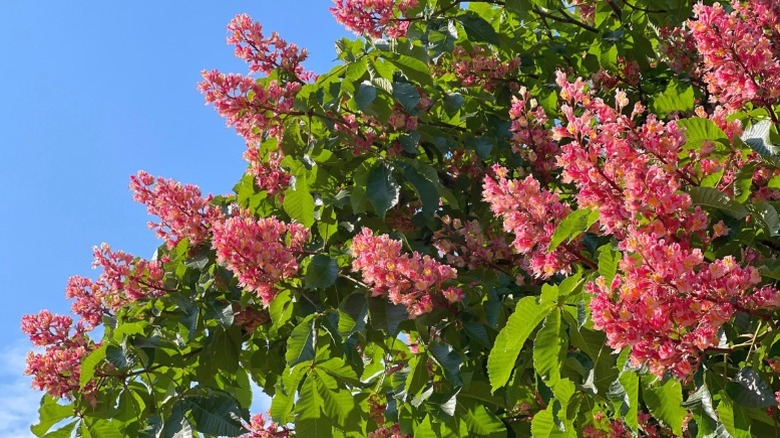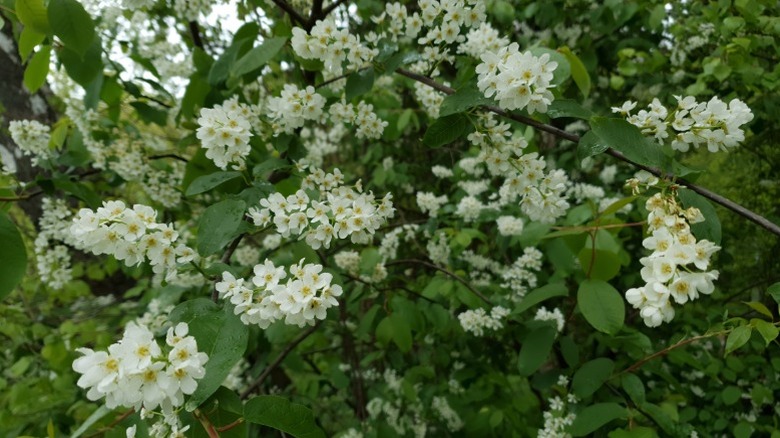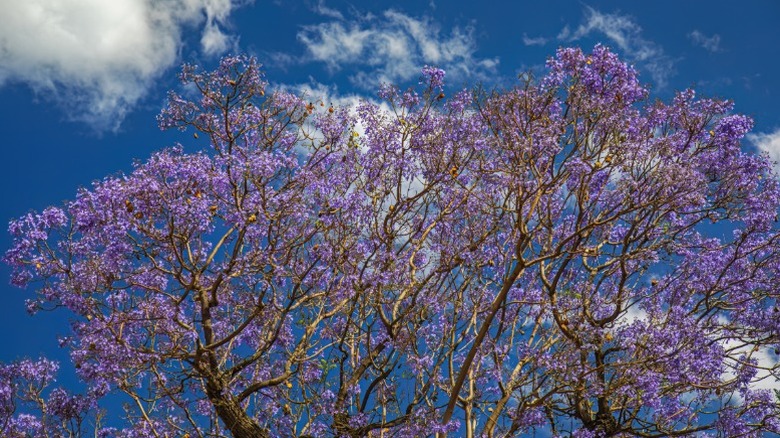17 Beautiful Flowering Trees That Can Bring Much-Needed Color To A Yard
While bold evergreens can add lovely blue-green shades to your yard, and many maples turn delightful colors in the fall, there's nothing quite like the burst of flowers from a flowering tree. If you feel that your outdoor space is lacking a little color, a pretty flowering species is a good option. Many flowering trees offer up their floral displays in spring, helping to usher in the season with extra vitality. However, there are selections that display beautiful blooms later in the season, too — crabapple, magnolia, red buckeye, and serviceberry, just to name a few.
Flowering trees are also incredibly versatile. Perhaps you want to use flowering trees to bring romance to your yard, or you want to add more pops of color to your outdoor space. With the many options regarding the color and shape of flowers or the size of the tree, you can easily adorn a small yard or a large space with beautiful flowering trees. Focus on one or two flowering species if you have a smaller space to grow, or create grand displays on larger properties.
Grow eastern redbud for cheerful purple flowers
One of the most popular flowering trees that are perfect for your yard, the eastern redbud (Cercis canadensis) is a native option for your yard. This species develops lovely, pea-like flowers in early spring in clusters that are a great attractant for butterflies, bees, and other pollinators. As a smaller tree, eastern redbuds make a decent ornamental choice because they don't get much taller than 30 feet with a short trunk or several trunks. They are hardy in USDA Hardiness Zones 4 through 9 and come in a variety of cultivars, like 'Forest Pansy' with bold burgundy flowers.
Experience year-round color with seven-son flower
A truly magical tree, the seven-son flower (Heptacodium miconioides) is characterized by showy white flowers in late summer. However, the color does not end there because after the petals fall off, the pink sepals remain. The outcome is the illusion that the seven-son flower tree is in flower again in autumn. Native to China, this tree is rare in the wild and does not have issues growing in the U.S., where it is hardy from zones 5 through 9.
Add early yellow color to your yard with cornelian cherry
The cornelian cherry (Cornus mas) is not actually a cherry tree. In fact, this yellow-flowering species is a dogwood native to Europe and southwestern Asia. A very early-flowering selection, the bright blooms are a welcome sight after winter. Depending on the weather, flowers can persist for weeks beginning in March. A very winter-hardy species, it is hardy in the U.S. from zones 4 through 8, although it is native to southern Europe and western Asia. Make sure to plant cornelian cherry trees in full or partial shade for the best growth.
Pick a fantastic cultivar of crabapple for delightful colors
In springtime, the bold flowers of crabapple (Malus spp.) appear to usher in spring officially. These small trees are related to apple trees but are part of the rose family. More than 500 cultivars of crabapples currently exist, with a variety of flower colors to choose from, ranging from white to red to rose pink. Adding a crabapple tree to your yard is one way to bring pollinators to your garden early. Crabapples are a flowering tree that'll attract hummingbirds with their nectar-rich flowers. The crabapple is hardy in the U.S. in zones 4 through 8.
Create a haven for hummingbirds with red buckeye
A pollinator-friendly tree, the red buckeye (Aesculus pavia), graces your landscape with tubular red flowers. This species is a smaller option, with cultivated varieties maxing out at heights of 15 to 20 feet. It is recognized immediately by its tubular-shaped flowers that come forth in spring, attracting hummingbirds, moths, and butterflies aplenty. Hardy in zones 6 through 9, it is recommended to plant the red buckeye in average, well-drained soil. However, they are not hard to grow or keep up, and they are a perfect showy specimen tree for any yard.
Provide showy flowers for springtime pollinators with serviceberry
Downy serviceberry (Amelanchier arborea), also known as juneberry or shadbush, is a native U.S. tree with superb adaptability and utility. From one season to the next, the downy serviceberry has something new to offer your senses. In early spring, it's their lovely, five-petaled white flowers. These fragrant blooms provide much-needed delight to landscapes after a long winter. Cultivated varieties have a narrow and rounded shape, topping out at 15 to 25 feet tall.
Grace a space with cup-shaped flowers from a saucer magnolia
So-called for their large, cup-shaped flowers, the hybrid saucer magnolia (Magnolia x soulangeana) tree is a ravishing addition to a big or small yard. Expect flowers, even on young saucer magnolia trees, to appear from February to April. This small tree is popular for its wide range of cultivars, offering different flower colors and shapes. Choose 'Alexandrina' for rose-purple flowers or 'Rustica Rubra' for rose-red flowers. Saucer magnolias are hardy in zones 4 through 9 in the U.S.
Showcase a wisteria-like, golden chain tree
Many popular flowering trees display pink, red, and purple flowers. But if you're seeking trees that bloom with gorgeous yellow flowers, try the golden chain tree (Laburnum anagyroides). This species was brought from Europe and has a graceful form with pendulous flowers, sometimes 10 inches long. Each spring, from May to June, this small tree develops sweetly-scented, pea-like flowers that spill down from the branches in a similar fashion to wisteria. Hardy in zones 5 through 7 in the U.S., it works well in various conditions, although it can be weedy. Note: Every part of the tree can be highly toxic if ingested.
Attract hummingbirds and more with a red bottlebrush tree
An evergreen species, the red bottlebrush (Melaleuca citrina) features unique red flowers in the form of spikes. Although sold as a shrub in many places, this plant grows well as a tree, reaching heights up to 25 feet. Native to Australia, this tree easily attracts hummingbirds, other pollinators, and even songbirds with its flowers and seeds. It is hardy in zones 9 through 11, blooming mainly only in summer in colder areas of the U.S., while throughout the year in other regions. It is not native to the U.S. but also will do no harm.
Plant attractive flowering dogwood for white, red, or pink hues
An eastern U.S. native, the flowering dogwood (Cornus florida) is famous for its early flowering habit. Pretty pink, red, or white bracts that give the appearance of much larger flowers add a stunning look to this tree. Flowering dogwoods are hardy from zones 5 through 9 and prefer acidic soil without heavy clay. Picky about soil conditions, ensure that it is not planted near possible pollutants or road salt. However, flowering dogwood can thrive in shade and tops out at around 20 feet tall.
Embrace red flowers with an adaptable maple tree
Capable of growing to great heights, red maple (Acer rubrum) is a quick-growing, stalwart species characterized by a rounded shape. Known as the red or scarlet maple, this tree gets its name not only from the shade its leaves turn in autumn but also from the delightful red flowers that come forth in late winter. These flowers appear in hanging clusters, sometimes all male, all female, or both, on one tree. This maple species is hardy from zones 2 through 9, particularly well-adjusted to cold temperatures.
Add magic to your garden with a Japanese flowering cherry
If you don't mind a tree that might only last for 20 years, a Japanese flowering cherry (Prunus serrulata) is a classic tree to add romance to your garden. One of the most popular cultivars is the 'Kwanzan,' which features double dark pink flowers. These trees are part of the rose family, and this cultivar, in particular, features very showy blooms. This Japanese flowering cherry is one of the best for cold climates, making it popular in the U.S. This cultivar is generally hardy from zones 5 through 9.
Try a tulip tree for uniquely-shaped, yellow flowers
A popular choice for home landscapes, the tulip tree (Liriodendron tulipfera) is a U.S. native with unique flowers. Called the yellow poplar or tulip poplar due to its greenish-yellow, tulip-shaped flowers, this species is a quick-growing option. Unfortunately, these lovely flowers might be hard to see unless you're looking for them, at least until they drop from the tree. Keep your eyes out in late spring to early summer to see big, goblet-shaped flowers. Tulip trees are hardy in zones 4 through 9 and typically grow in a columnar manner, with a tall, narrow form.
Enjoy the pleasing smell of white fringetree flowers
A refreshing scent is emitted from the pretty fringetree (Chionanthus virginicus), also known as old man's beard or grancy graybeard. This species is related to lilacs and olives, so it's not a surprise that its flowers have a fragrance reminiscent of lilacs. The combination of the dainty, long white petals and the pleasant smell make this an ideal native tree. On the smaller side, fringetrees are great ornamental options with a slow, steady growth rate. Hardy from zones 3 through 9, this species displays clusters of fringe-like petals in the spring.
Introduce the red horsechestnut, a hybrid that attracts bees
Created from two separate species, the red horsechestnut (Aesculus x carnea) features lively pink or red blooms that attract bees to your yard. It pairs palm-shaped leaves with bright red flowers, a stunning springtime display. The cone-shaped flowers appear on 6 to 8-inch long clusters, easily getting the notice of hummingbirds, too. Red horsechestnuts are hardy from zones 4 through 9. This tree drops seed pods after flowering each season. Don't plant it where this habit will be a nuisance. However, these trees are widely used for residential yards, parks, and parkways. Note that the husked seeds are toxic.
Try chokecherry to deliver beautiful flowers and fruit
A smaller species, chokecherry (Prunus virginiana), grows about 20 to 30 feet tall at maturity. This ornamental tree, also called wild cherry or bitter berry, features dense white flowers in spring with a delightful fragrance, followed by pretty reddish-purple fruit later in the summer. Chokecherry is native to a wide range of the U.S. and hardy from zones 2 through 7. Adding this tree to your yard is a great way to have a beautiful focal point in your landscaping that is beneficial to wildlife, including native bees.
Use jacaranda for unusual purple-blue flowers
To add a little something extra to your yard, consider using the bold blooms of the jacaranda (Jacaranda mimosifolia). One of the unique trees that bloom with beautiful blue flowers, jacaranda's flowers are large and create an impressive display in spring. Although this tropical species is not native to the U.S., it is hardy in zones 9 through 13 and grows successfully in southern states. Be careful when planting jacaranda, as it offers a glorious mess from fallen flowers and leaves. Add this lush tree to your yard for its thrilling colors and tall, upright growth.
